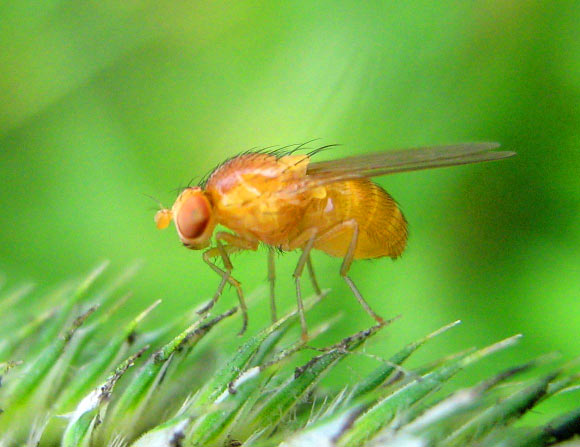A new study published in the journal Current Biology shows that the response of fruit flies (Drosophila sp.) to visual threats includes many essential elements of what is called fear.

Drosophila melanogaster. Image credit: Botaurus.
Insects are an important model for the study of emotion; although mice are closer to humans on the evolutionary family tree, the fruit fly has a much simpler neurological system that is easier to study.
However, studying emotions in insects or any other animal can also be tricky. Because scientists know the experience of human emotion, they might anthropomorphize those of an insect – just as you might assume that the shooed-away fly left your plate because it was afraid of your hand.
“No one will argue with you if you claim that flies have four fundamental drives just as humans do: feeding, fighting, fleeing, and mating. Taking the question a step further – whether flies that flee a stimulus are actually afraid of that stimulus – is much more difficult,” said study lead author Dr William Gibson of California Institute of Technology in Pasadena.
In their study, Dr Gibson and his colleagues dissected fear into five building blocks, which they refer to as ‘emotion primitives.’
“If we can show that fruit flies display all of these separate but necessary primitives, we then may be able to make the argument that they also have an emotion, like fear,” he said.
The emotion primitives analyzed by Dr Gibson’s team can be understood in the context of a stimulus associated with human fear: the sound of a gunshot.
If you hear a gun fire, the sound may trigger a negative feeling. This feeling, a primitive called valence, will probably cause you to behave differently for several minutes afterward. This is a primitive called persistence.
Repeated exposure to the stimulus should also produce a greater emotional response – a primitive called scalability; for example, the sound of 10 gunshots would make you more afraid than the sound of one shot.
Another primitive of fear is that it is generalized to different contexts, meaning that if you were eating lunch or were otherwise occupied when the gun fired, the fear would take over, distracting you from your lunch. Trans-situationality is another primitive that could cause you to produce the same fearful reaction in response to an unrelated stimulus – such as the sound of a car backfiring.
“In terms of these building blocks of fear, does a fruit fly’s response to shadows resemble our response to the sound of a gun?” Very much so, the study shows.
The scientists came to that conclusion after enclosing flies in an arena where they were exposed repeatedly to an overhead shadow.
They carefully analyzed the fruit flies’ behaviors as captured on video, which showed that shadows promoted graded and persistent increases in the flies’ speed and hopping.
Occasionally, the insects froze in place, a defensive behavior also observed in the fear responses of rodents. The shadows also caused hungry flies to leave a food source, suggesting that the experience was generally negative and generalized from one context to another.
It took time before those flies would return to their food following their dispersal by the shadow, suggesting a slow decay of the insects’ internal, defensive state.
Importantly, the more shadows the flies were exposed to, the longer it took for them to ‘calm down’ and return to the food.
In other words, when fruit flies flee in response to a shadow, it’s more than a momentary escape.
It’s a lasting physiological state much like fear. And, if that’s true, it means that flies could help us understand in a very fundamental way what fear and other emotions are made of.
_____
William T. Gibson et al. Behavioral Responses to a Repetitive Visual Threat Stimulus Express a Persistent State of Defensive Arousal in Drosophila. Current Biology, published online May 14, 2015; doi: 10.1016/j.cub.2015.03.058







